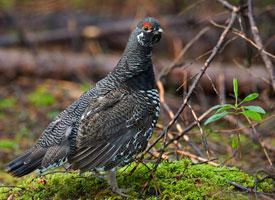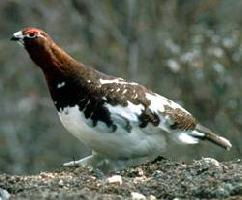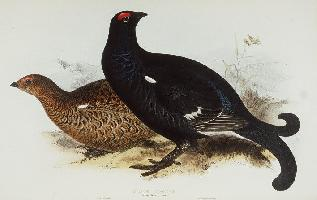
Description de l'animal
The Spruce grouse, scientifically known as Canachites canadensis, is a fascinating bird species native to the boreal forests of North America. This medium-sized grouse is renowned for its remarkable adaptation to its coniferous forest habitat, making it a symbol of the wild, unspoiled wilderness areas it inhabits.Physically, the Spruce grouse is a sturdy bird with a compact body, rounded wings, and a short, square tail. Males and females display distinct plumage, which varies slightly depending on their geographical location. Males are particularly striking with their dark, blackish-brown feathers that contrast sharply with their light grey underparts. They boast a unique feature in the form of bright red wattles over their eyes, which become more pronounced during the mating season. Females, on the other hand, are mottled brown and white, a coloration that provides excellent camouflage against the forest floor as they tend to their nests.
One of the most intriguing aspects of the Spruce grouse's biology is its diet. This bird has a highly specialized diet that primarily consists of the needles of coniferous trees such as spruce and pine. In the winter, when other food sources are scarce, these needles become the grouse's sole sustenance. This diet is highly unusual for birds and requires a specialized digestive system capable of breaking down the tough, resinous needles.
The Spruce grouse is known for its unassuming behavior. It is not particularly wary of humans, often allowing close approach, which has earned it the nickname "fool hen" in some regions. However, this behavior is more a testament to the bird's adaptation to its secluded forest environment, where predators are more often detected by sound than by sight.
Breeding season brings out the most dramatic behaviors in the Spruce grouse. Males perform elaborate displays to attract females, fanning their tails, puffing up their plumage, and emitting deep, throaty calls. They are polygynous, meaning a single male may mate with several females. After mating, the female is solely responsible for nest-building, incubation, and raising the chicks. She lays her eggs on the ground, in a simple nest hidden among the forest underbrush, where the chicks are born precocial, ready to leave the nest shortly after hatching.
The Spruce grouse's habitat is closely tied to the boreal forest, a vast biome characterized by cold temperatures, short growing seasons, and predominantly coniferous trees. These forests provide the necessary food and cover for the Spruce grouse, making conservation of these areas crucial for the species' survival. Although currently not considered endangered, the Spruce grouse's reliance on this specific habitat makes it vulnerable to the effects of deforestation and climate change.
In summary, the Spruce grouse is a remarkable bird species, emblematic of the North American boreal forests. Its unique adaptations, from its specialized diet to its breeding behaviors, underscore the intricate balance of these ecosystems. As such, the Spruce grouse serves as a living reminder of the importance of conserving the natural world and its diverse inhabitants.
Animaux similaires
Nouvelles photos d'animaux
Top 10 des animaux
- Dolphin gull (Leucophaeus scoresbii)
- Diana monkey (Cercopithecus diana)
- Moustached guenon (Cercopithecus cephus)
- Galápagos tortoise (Geochelone nigra complex)
- Russian tortoise (Testudo horsfieldii)
- Japanese macaque (Macaca fuscata)
- Stone loach (Barbatula barbatula)
- Greek tortoise (Testudo graeca)
- Common flying dragon (Draco volans)
- Colossal squid (Mesonychoteuthis hamiltoni)


